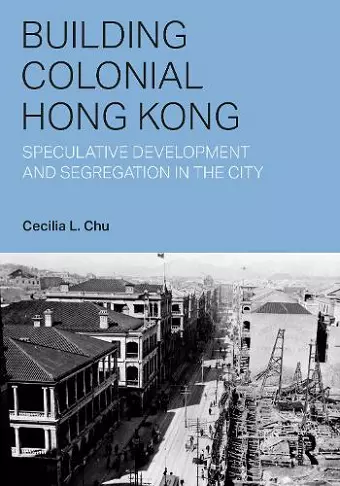Building Colonial Hong Kong
Speculative Development and Segregation in the City
Format:Hardback
Publisher:Taylor & Francis Ltd
Published:15th Apr '22
Should be back in stock very soon
This hardback is available in another edition too:
- Paperback£41.99(9781032262925)

In the 1880s, Hong Kong was a booming colonial entrepôt, with many European, especially British, residents living in palatial mansions in the Mid-Levels and at the Peak. But it was also a ruthless migrant city where Chinese workers shared bedspaces in the crowded tenements of Taipingshan. Despite persistent inequality, Hong Kong never ceased to attract different classes of sojourners and immigrants, who strived to advance their social standing by accumulating wealth, especially through land and property speculation.
In this engaging and extensively illustrated book, Cecilia L. Chu retells the ‘Hong Kong story’ by tracing the emergence of its ‘speculative landscape’ from the late nineteenth to the early decades of the twentieth century. Through a number of pivotal case studies, she highlights the contradictory logic of colonial urban development: the encouragement of native investment that supported a laissez-faire housing market, versus the imperative to segregate the populations in a hierarchical, colonial spatial order. Crucially, she shows that the production of Hong Kong’s urban landscapes was not a top-down process, but one that evolved through ongoing negotiations between different constituencies with vested interests in property. Further, her study reveals that the built environment was key to generating and attaining individual and collective aspirations in a racially divided, highly unequal, but nevertheless upwardly mobile, modernizing colonial city.
Awarded 2023 Best Book in Non-North American Urban History by the Urban History Association.
Cecilia Chu has a second award: she received the 2024 IPHS book prize for the best book written in English and related to the planning history of the country/region where the IPHS conference is hosted. This was presented at the IPHS conference in Hong Kong in July 2024.
'This is a stellar, insight-filled, and beautifully written analysis of the built environment of one of the world’s most remarkable and still-politically-charged metropolises: ‘the fragrant harbour’ (Xianggang) or, as most know it, Hong Kong.… those with an interest in Hong Kong’s evolution – from a colonial entrepôt to a Chinese city … will learn key lessons from an extremely perceptive scholar, who writes with clarity and insight.'
-Jeff Cody, The Getty Conservation Institute
'Building Colonial Hong Kong is necessary reading for scholars and students of colonial urbanization and planning … Chu’s book is of significance to a much wider audience, who will find in colonial Hong Kong provocative and disquieting similarities to many of the challenges faced by contemporary planners around the world.'
-Nick R. Smith, Barnard College
'This is a stellar, insight-filled, and beautifully written analysis of the built environment of one of the world’s most remarkable and still-politically-charged metropolises: ‘the fragrant harbour’ (Xianggang) or, as most know it, Hong Kong.… those with an interest in Hong Kong’s evolution – from a colonial entrepôt to a Chinese city … will learn key lessons from an extremely perceptive scholar, who writes with clarity and insight.'
Jeff Cody, The Getty Conservation Institute
'Building Colonial Hong Kong is necessary reading for scholars and students of colonial urbanization and planning … Chu’s book is of significance to a much wider audience, who will find in colonial Hong Kong provocative and disquieting similarities to many of the challenges faced by contemporary planners around the world.'
Nick R. Smith, Barnard College
'Chu’s book is a subtle and significant work in urban colonial history, exposing the speculation and self-interest that drove Hong Kong’s economy and that shaped so many lives through its physical production.'
Christopher Cowell, Journal of the Society of Architectural Historians, December 2023
'The urban history of Hong Kong has been well researched, but few works to date have been as robust and lucid as Cecilia Chu’s Building Colonial Hong Kong: Speculative Development and Segregation in the City. Harnessing first-hand sources and focusing on ever-present housing issues, she vividly narrates the history of its urban territories from 1840 through to the 1930s.'
Puay Peng Ho, National University of Singapore. Fall 2024 issue of Traditional Dwellings and Settlements Review.
'Cecilia L. Chu’s book pinpoints the complexities of Hong Kong’s urban space by providing new perspectives. She thus opens a new chapter of reading and understanding of colonial urban Hong Kong…Overall, the book provides a chronological exploration of divergent discourses weaving through early colonial Hong Kong, offering a comprehensive view of urban planning. Chu integrates interdisciplinary materials in a clear manner via economics, history, and architecture, hence offering an interdisciplinary approach lacking in previous studies.'
Catherine Li Lanqing, Hong Kong Studies Vol. 4, No. 2 (Winter 2024).
ISBN: 9781138344655
Dimensions: unknown
Weight: 627g
228 pages